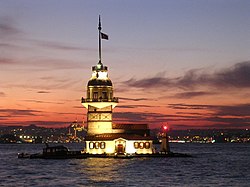Kız Kulesi, hakkında çeşitli rivayetler anlatılan, efsanelere konu olan, İstanbul Boğazı'nın Marmara Denizi'ne yakın kısmında, Salacak açıklarında yer alan küçük adacık üzerinde inşa edilmiş yapıdır.
Üsküdar'ın sembolü haline gelen kule, Üsküdar’da Bizans devrinden kalan tek eserdir. M.Ö. 24 yıllarına kadar uzanan tarihi bir geçmişe sahip olan kule, Karadeniz’in Marmara ile birleştiği yerde küçük bir ada üzerinde kurulmuştur. Bazı Avrupalı tarihçiler buraya Leander Kulesi derler. Kule hakkında pek çok rivayetler bulunmaktadır. Evliya Çelebi kuleyi şöyle tarif eder:
Deniz içinde karadan bir ok atımı uzak, dört köşe, sanatkarane yapılmış bir yüksek kuledir. Yüksekliği tam seksen arşundur. Sathı mesehası iki yüz adımdır. İki taraftan yerde kapısı vardır.
Bugün görülen kulenin temelleri ve alt katın önemli kısımları Fatih devri yapısıdır. Kulenin etrafındaki sahanlık geniş kaplanmıştır. Üstündeki madalyon halindeki bir mermer levhada, kuleye şimdiki şeklini veren Sultan II. Mahmut’un, Hattat Rasim’in kaleminden çıkmış 1832 tarihli bir tuğrası vardır. Kulenin Eminönü tarafı daha genişçe olup burada bir de sarnıç vardır.
İlk olarak Yunan döneminde bir mezara ev sahipliği yapan bu ada Bizans döneminde inşa edilen ek bina ile gümrük istasyonu olarak kullanılmıştır. Osmanlı döneminde ise gösteri platformundan, savunma kalesine, sürgün istasyonundan, karantina odasına kadar bir çok işlev yüklenmiştir. Asli görevi olan ve yüzyıllardan beri varlığı ile insanlara, geceleri ise geçen gemilere göz kırpan feneri ile yol gösterme işlevini hiç kaybetmemiştir.Geçmişten geleceğe en çok da düşlere yol göstermektedir Kız Kulesi. Kız Kulesi 2000 yılında restore edilerek, artık çatal-bıçak seslerinin duyulduğu bir mekân haline dönüştürülmüştür. Kız kulesine ulaşım Salacak ve Ortaköy'den sandallarla yapılmaktadır.
Çok eski tarihi geçmişi olan Kız Kulesi, bir zamanlar, Boğazdan geçen gemilerden vergi alınmak maksadı ile kullanılmıştır. Kule ile Avrupa Yakası boyunca büyük bir zincir çekilmiş ve gemilerin Anadolu Yakası ile Kız Kulesi arasından geçişine(o zamanlar gemi boyutları küçük olduğu için geçebilmekteydi) izin verilmiştir. Bir süre sonra Kule, zinciri taşıyamamış ve Avrupa Yakasına doğru yıkılmıştır. Kuleden suyun içinde bakıldığında yıkıntıları görülmektedir.
Antik Çağ'da Arkla(küçük kale) ve Damialis(dana yavrusu) adları ile anılan kule, bir ara da "Tour de Leandros"(Leandros'un kulesi) ismi ile ün yapmıştır. Şimdi ise Kız Kulesi ismi ile bütünleşmiş ve bu ismi ile anılmaktadır.
Vikipedi, özgür ansiklopediden alıntıdır
History
Maiden's Tower was first built by the ancient Athenian general Alcibiades in 408 BC to control the movements of the Persian ships in the Bosphorus strait.[2] Back then the tower was located between the ancient cities of Byzantion and Chrysopolis. The tower was later enlarged and rebuilt as a fortress by the Byzantine emperor Alexius Comnenus in 1110 AD, and was restored and slightly modified several times by the Ottoman Turks, most significantly in 1509 and 1763.[3] The most recent facelift was made in 1998.[4] Steel supports were added around the ancient tower as a precaution after the 17 August 1999 earthquake.
Used as a lighthouse for centuries, the interior of the tower has been transformed into a popular café and restaurant, with an excellent view of the former Roman, Byzantine and Ottoman capital.[5] Private boats make trips to the tower several times a day.[6]
[edit] Legend
There are many legends about the construction of the tower and its location. According to the most popular Turkish legend, a sultan had a much beloved daughter. One day, an oracle prophesied that she would be killed by a venomous snake on her 18th birthday. The sultan, in an effort to thwart his daughter's early demise by placing her away from land so as to keep her away from any snakes, had the tower built in the middle of the Bosphorus to protect his daughter until her 18th birthday. The princess was placed in the tower, where she was frequently visited only by her father.
On the 18th birthday of the princess, the sultan brought her a basket of exotic sumptouous fruits as a birthday gift, delighted that he was able to prevent the prophecy. Upon reaching into the basket, however, an asp that had been hiding among the fruit bit the young princess and she died in her father's arms, just as the oracle had predicted. Hence the name Maiden's Tower.
The older name Leander's Tower comes from another story about a maiden: the ancient Greek myth of Hero and Leander. Hero was a priestess of Aphrodite who lived in a tower at Sestos, at the edge of the Hellespont (Dardanelles). Leander (Leandros), a young man from Abydos on the other side of the strait, fell in love with her and would swim every night across the Hellespont to be with her. Hero would light a lamp every night at the top of her tower to guide his way.
Succumbing to Leander's soft words, and to his argument that Aphrodite, as goddess of love, would scorn the worship of a virgin, Hero allowed him to make love to her. This routine lasted through the warm summer. But one stormy winter night, the waves tossed Leander in the sea and the breezes blew out Hero's light, and Leander lost his way, and was drowned. Hero threw herself from the tower in grief and died as well. The name Maiden's Tower might also have its origins in this ancient story.
Due to the vicinity and similarity between the Dardanelles and the Bosphorus, Leander's story was attributed to the tower by the ancient Greeks and later the Byzantines.
_by_Florentine_cartographer_Cristoforo_Buondelmonte.jpg/250px-Map_of_Constantinople_(1422)_by_Florentine_cartographer_Cristoforo_Buondelmonte.jpg)

Hiç yorum yok:
Yorum Gönder